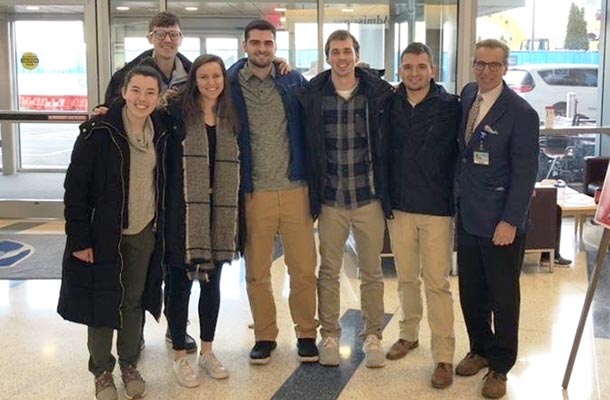
Capstone project team stands with Dr. Alex Marmourian at Penn State Milton S. Hershey Medical Center. Photo taken February 2020. Left to right: Hannah Kemper, Peter Selinsky, Meredith Bachman, Derek Jones, Timothy Hogan, Chris Birett, Dr. Alex Mamourian. IMAGE: PETER SELINSKY
Two teams of engineering students emerge as capstone project award winners
8/19/2020
By Mia Hollie
UNIVERSITY PARK, Pa. — Two undergraduate teams at Penn State were recognized by the Harold and Inge Marcus Department of Industrial and Manufacturing Engineering’s Service Enterprise Engineering Initiative (SEE 360) for their capstone projects that embodied the initiative’s motto, “engineering the 21st century service economy.”
The Bernard M. Gordon Learning Factory’s capstone design program is an industry-university partnership that integrates design, manufacturing, service engineering and business into the engineering curriculum and enables teams of students from all engineering disciplines to work together to address industry issues. SEE 360 sought teams whose projects aligned with its goal to develop applications of classical engineering techniques to improve service process productivity.
Engineering better medical practices
Biomedical engineering students Meredith Bachman, Christopher Birett, Timothy Hogan, Keith Derek Jones, Hannah Kemper and Peter Selinsky, won recognition for their project, “Guide for Placement of External Ventricular Drain.” Hershey Medical Center’s Department of Radiology sponsored the students’ research.
“I was drawn to the human aspect of it,” Bachman said. “To have the opportunity and resources that we have at Penn State to apply ourselves in this way was something I looked forward to when beginning the project.”
Surgeons use external ventricular drains to relieve pressure caused by built up fluid in the brain’s ventricles, but the current surgical machines used in this process are often costly and require multiple people to operate. The students wanted to create a tool that was cost effective and could also be used by a single surgeon.
The team created two designs. The first is a ball-and-socket device, similar to a joystick, that mounts to a patient’s skull and allows the surgeon to pivot to the correct angle for insertion. The other device is a hollowed tube that slides along a headband-like structure connected to the patient’s ears. Because all patients who undergo the procedure must also have a CAT scan, the angle of insertion would be readily available.
“They would be able to move the device and secure it in place. The only thing left to do would be to insert the catheter through the cylinder,” Selinsky said. “Both are very easy and hands-off approaches.”
Innovation in nuclear testing facilities
Mechanical engineering students Bogdan Bordean, Felix Amon and Kyle Jacobs, and energy engineering students Majed Khalaf and Matthew Witt, won the runner-up award for their project, “Nuclear Process Loop Control System.” Sponsored by Exelon Nuclear Innovation, the team’s work serves as a sub-project of Exelon’s larger initiative to build a civil nuclear testing facility.
The project serves as an expansion of previous capstone projects, with the end goal of a commercial pressurized water reactor (PWR), a common type of nuclear reactor that generates electricity to propel submarines and naval vessels.
“The Breazeale Nuclear Reactor is a test reactor, so it doesn’t create electricity,” Jacobs said. “Because of this, we created a system that could simulate a fully functioning pressurized water reactor that Exelon could use when the entire project is completed.”
The team was tasked with designing the high-pressure portion of the PWR’s process loop system. Similar to how a thermostat maintains a given temperature, a process loop maintains water pressure in a PWR. The team created a three-dimensional model of the process loop and provided Exelon with a bill of materials and two calculations to aid in maintaining the system’s temperature and pressure.
Future applications
Now that students from both teams have graduated with their bachelor’s degrees, they feel the ability to apply engineering techniques to solve problems can help them in any field they wish to pursue.
“One of the reasons I like engineering is because you are presented with problems and you have to solve them,” Jacobs said. “You get to go through it step-by-step while facing trial and error — it’s pretty real life.”
Kemper plans to teach high school math after completing her master’s degree in education at the University of Notre Dame. Although her career path varies from her undergraduate education, the lessons she learned are applicable to any field, she said.
“One thing that I think we can all take away from this project, and something I want to instill in my students, is that if you apply yourself, you can do anything you set your mind to,” Kemper said.
About SEE 360
SEE 360, as part of the Harold and Inge Marcus Department of Industrial and Manufacturing Engineering at Penn State, aims to engineer the 21st-century economy by educating students on how they can find and solve service industry problems. The initiative offers a minor degree, works on developing teaching resources such as textbooks and case studies and introduces students to opportunities for engineering in labor-intensive service industries by partnering with businesses to optimize service. For more information, visit see360.psu.edu.



